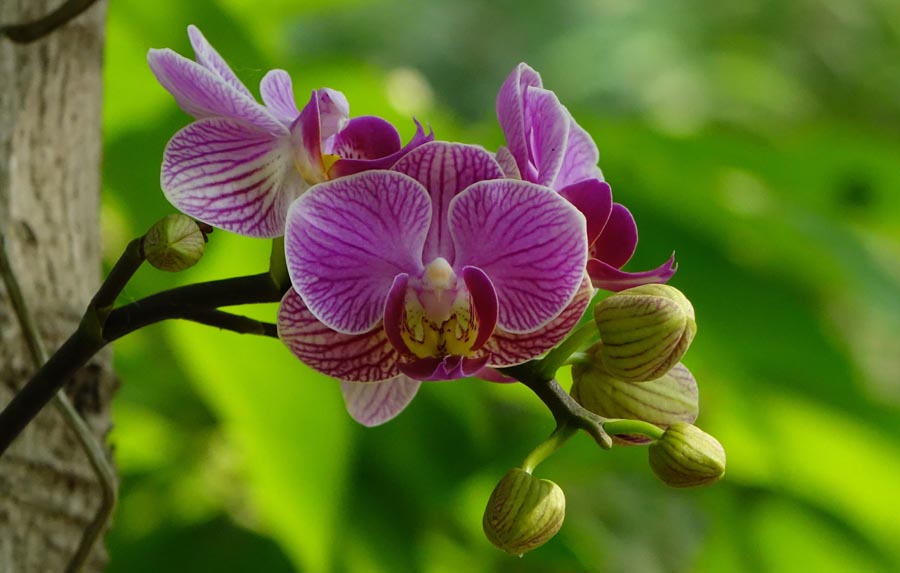
Along with sunflowers, orchids are the biggest family in the plant kingdom.
So I guess it is of use to be able to answer the question are orchids monocots or dicots?
In fact, answering that question throws up a few interesting facts about this wonderful plant.
So without further ado let’s delve into the fascinating world of orchids.
Are Orchids A Monocot or Dicot?
Orchids are monocots. They have a seed that sprouts a single leaf, leaves that are parallel-veined and they bear petals in multiples of three – all consistent with monocot plants. In addition to this orchids have a number of distinct characteristics that make them quite unique to many flowering plants.
What Are Monocots and Dicots?
Before we deal with the main question it is important to have an understanding of exactly what monocots and dicots are.
It is important because of around 300,000 flowering plants in the world, around 75% are classed as dicots and 23% are monocots (the remaining 2% are categorised as basal angiosperms).
At their most basic level monocots and dicots are distinguished by the number of leaves that sprout from the initial seed.
RELATED ===> What Does An Orchid Smell Like?
These are not true leaves but are referred to as seed leaves
Monocots sprout one seed leaf, whereas dicots sprout two seed leaves.
Some other basic differences are outlined in the table below:
| Monocots | Dicots | |
| Seed leaves | One | Two |
| Petals | In multiples of three | In multiples of four or five |
| Leaves | Veins that run parallel to each other | Veins branch out from the center of the leaf to the edges |
| Roots | Adventitious roots that are fibrous spreading | Tap roots |
| Stems | Vascular bundles are spread throughout | Vascular bundles are around the outside |
Examples of monocots and dicots include:
- Monocots: Maize, wheat, rice, bamboo, lilies and palms
- Dicots: Beans, maples, oaks, poplars, daisies and petunias
Essentially plants are either monocots or dicots because of their ancestry.
Millions and millions of years ago all plants descended from a common ancestor that was a monocot.
Then, around 200million years ago, a split occurred and a species evolved that had two seed leaves and was the first dicot.
Ever since then plants that descended from the ancient monocots continued to be monocots, whilst plants that came from original dicot continued to be dicots.
One more thing.
Monocots and dicots plants are both angiosperms. Angiosperms are any plants with flowers that have their seeds enclosed within their fruit.
The other category of flowering plants is gymnosperms. These include spruces, pines and redwoods.
They are different from angiosperms as they don’t have flowers or fruits. Instead, their seeds are on the surfaces of their leaves and are dispersed by the wind.
Gymnosperms are also evergreen, whereas angiosperms are seasonal.
Why Are Orchids Monocots?
Orchids have all the characteristics listed above.
They have a single seedling leaf, parallel-veined leaves and generally their flowers bear petals in multiples of three.
RELATED ===> How To Quarantine Orchids?
I say generally because phalaenopsis orchids are an exception to the rule having only two true petals.
Monocots also have soft stems and fibrous roots. In fact, this is how the orchid got its name.
Their thick tuber-like roots resembled paired testicles. The Greek word ‘orchis’ means testicle!
How Are Orchids Different From Other Plants?
Orchids have a number of unique features, but botanists agree that one aspect above all others differentiates them from other flowering plants.
The male part of the flower, the stamen, and the female part of the flower, the style, are fused together into one structure called the column. This is often visible protruding from the center of the flower.
Another unusual feature of orchids is the way they trick insects into pollinating them.
Every orchid is shaped, colored and scented in a particular way to attract a different species of insect. In fact some orchids have evolved to look like flowers nearby them which confuses the pollinators, and some even look and smell like female insects.
One petal on an orchid is usually specialized to attract insects and to act as a landing pad. Some are large with intricate patterns, some are narrow and thin and some, as hinted at above, look like a version of the insect, so the insect tries to mate with it.
RELATED ===> Should I Remove The Plastic From My Orchid?
The structure of the orchid directs the insect towards the pollen and encourages them to pick it up and take it to a different orchid, transferring it to the stigma at the top of the column as they do so.
Unlike other flowers, the pollen grains of an orchid are formed together in packers called pollinia.
Another way in which orchids are unique is in their reproduction strategy. They focus much more on quantity over quality and produce large numbers of tiny seeds that lack endosperm.
They can produce millions of seeds per seed pod that are distributed by the wind over a large area.
Final Thoughts

So as you can see Orchids really are quite remarkable plants.
They grow from the Arctic to the Equator and in every continent except Antarctica.
They also contain more species than any other family of plants. Unfortunately, as rainforests are destroyed we are probably losing many undiscovered species of orchid.
They are fascinating plants, particularly in the way they attract insects and the way they are structured.
Orchids are monocots, but they are no normal monocots!
